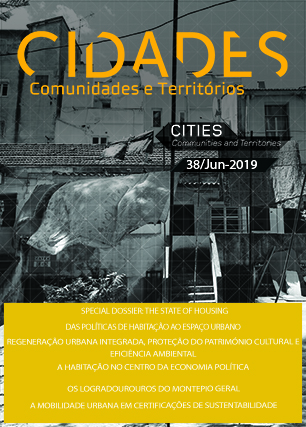The representativeness of urban mobility in sustainability certifications
Keywords:
urban mobility, sustainability certification, sustainability, urban environmentAbstract
The demand for mobility and the increasing dependence on private vehicles for intra-metropolitan journeys in particular, is currently one of the main issues in the debate on sustainable urban development, since it is responsible for several social, economic and environmental impacts. Several certifications with the purpose of measuring sustainability in the urban environment present different criteria and strategies listed as relevant in their evaluation methods. In this context, the present study questions how mobility is addressed in urban sustainability indexes, from the perspective of their importance for the quality of life in cities. For this purpose, the LEED, BREEAM and AQUA certifications were analyzed and compared in the categories referring to neighbourhoods and new sustainable buildings, presenting the comparison of the importance invested to the mobility components in each category of evaluation. The results suggest that the BREEAM certification presents greater representativeness among the three certifications analyzed, followed by the LEED certification. The analysis also indicated that the category of neighborhoods shows significantly higher relevance in terms of the percentage range of the score that encompasses this subject. This approach to certifications can help in the visibility of more efficient and sustainable practices of urban mobility, improving the urban environment and enhancing the quality of life in cities.
References
BARGOS, D. C.; MATIAS, L. F. Mapeamento e análise de áreas urbanas em Paulínia (SP): estudo com a aplicação de geotecnologias. Sociedade & Natureza, v. 24, p. 143–156, 2012.
CAMAGNI, R.; GIBELLI, M. C.; RIGAMONTI, P. Urban mobility and urban form: the social and environmental costs of diferente patterns of urban expansion. Ecological Economics, n. 40, 2002.
GARAU, C.; MASALA, F.; PINNA, F. Cagliari and smart urban mobility: analisys and comparison. Cities, n. 56, 2016.
GUERRA, J. B. S. O. A.; RIBEIRO, J. M. P.; FERNANDEZ, F.; BAILEY, C.; BARBOSA, S. B.; NEIVA, S. S. The adoption of strategies for sustainable cities: a comparative study between Newcastle and Florianópolis focused on urban mobility. Journal of Cleaner Production, n. 113, 2016.
LONDE, P. R.; MENDES, P. C. A Influência das Áreas Verdes na Qualidade de Vida Urbana. Revista Brasileira de Geografia Médica e da Saúde, v. 10, n. 18, p. 264–272, 2014.
MAY, A. D. Encouraging good practice in the development of Sustainable Urban Mobility Plans. Case Studies on Transport Policy, n. 3, 2015.
MIRANDA, H. F.; SILVA, A. N. R. Benchmarking sustainable urban mobility: the case of Curitiba, Brazil. Transport Policy, n. 21, 2012.
SILVA, A. N. R.; COSTA, M. S.; MACEDO, M. H. Multiple views of sustainable urban mobility: the case of Brazil. Transport Policy, n. 15, 2008.
SILVA, A. N. R.; FILHO, M. A. N. A.; MACEDO, M. H.; SORRATINI, J. A.; SILVA, A. F.; LIMA, J. P.; PINHEIRO, A. M. G. S. A comparative evaluation of mobility conditions in selected cities of the five Brazilian regions. Transport Policy, n. 37, 2015.
SILVA, G.; ROMERO, M. Sustentabilidade urbana aplicada: Análise dos processos de dispersão, densidade e uso e ocupação do solo para a cidade de Cuiabá, Estado de Mato Grosso, Brasil. EURE, v. 41, n. 122, p. 209–237, 2015.
Downloads
Published
Issue
Section
License
CIDADES, Comunidades e Territórios by DINÂMIA'CET-Iscte is licensed under a CC-BY licence.






